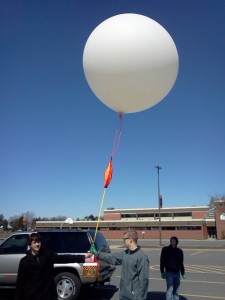
Jeff Ballard ’14 and Andrew Kristof ’14 with Icarus I
Although they are first-year students, Jeff Ballard ’14 (Hershey, Pa.) and Andrew Kristof ’14 (Darien, Conn.) couldn’t wait until their first hands-on engineering course. That’s why they started a project on their own and pitched it to the student chapter of the American Society of Mechanical Engineers (ASME). Their project earned second place this month at the regional ASME Student Professional Development Conference’s Oral Presentation Competition at Temple University.
“Jeff and I went to the conference expecting the worst, like last place, and to place so highly is a fantastic thing to accomplish,” says Kristof. “We beat out several senior design projects and even a grad student. We’re confident we can move up to first place in coming years.”
They designed a helium filled high-altitude balloon capable of carrying a small payload to near-space. This “micro satellite” housed high definition cameras, a GPS tracking module, and a parachute system while protecting them from the 200 mile per hour winds and negative 70°C temperatures of the upper atmosphere. At the balloon’s bursting altitude, it expands to its limit and pops, dropping the payload back through the atmosphere. The payload is slowed by a high-speed parachute, and the team recovers it by tracking its GPS signal. They named the Strato-SAT balloon “Icarus I” and completed it in about one month.
Ballard and Kristof recruited some very enthusiastic members of Lafayette’s chapter of ASME to assist with Icarus I. The student team included ASME chapter president Augustus Henninger ’12 (Hillsborough, N.C), Adam Spitulnik ’12 (Evanston, Ill.), Nicholas Moneta ’12 (Bellmore, N.Y.), Peter Lowe ’12 (Camp Hill, Pa.), David Ellis ’12 (Berwyn, Pa.), Juan Puerta ’12 (Bogota, Colombia), Megan Schultz ’12 (Dillsburg, Pa.), Brendan Flood ’13 (Exton, Pa.), Jared Katz ’12 (Stoneham, Mass.), Felix Hutchison ’12 (Plainsboro, N.J.), and Alexander Policastro ’11 (Massapequa, N.Y.). Faculty advisers include Richard Merz and Scott Hummel, associate professors of mechanical engineering, Daniel Sabatino and Jenn Stroud Rossmann, assistant professors of mechanical engineering, J. Ronald Martin, professor of chemical engineering, and Anthony Novaco, Metzgar Professor of Physics.
When searching for colleges, one of the things about Lafayette that impressed Ballard the most was the accessibility of its engineering resources. He recalls approaching Rossmann about testing the balloon.
“We walked into Professor Rossmann’s office and asked if we could test our prototype in the wind tunnel in her lab,” he says. “She said, ‘Sure, what time is good for you?’ At any other school, two undergraduate first-year students might have been laughed out of the office.”
Future plans for the project are underway. Next semester, the team’s second mission will be an interdisciplinary project in collaboration with the student chapter of the Institute of Electrical and Electronics Engineers (IEEE). The next launch will have a more sophisticated payload and possibly a rocket-balloon hybrid called a “rockoon.”
Both team leaders agree that this has been an extraordinary learning experience and they’re eager to bring more interested students on board next semester.
“It’s really been a fantastic experience doing this project as a freshman,” says Kristof. “I’ve been able to use a lot of labs used by upperclassmen and interact with technicians and professors along the way. Already having a relationship with professionals in Acopian Engineering Center will play a big part in my future here at Lafayette. Being an engineer is a lot of work, but definitely worth it because of projects like this.”

1 Comment
Comments are closed.